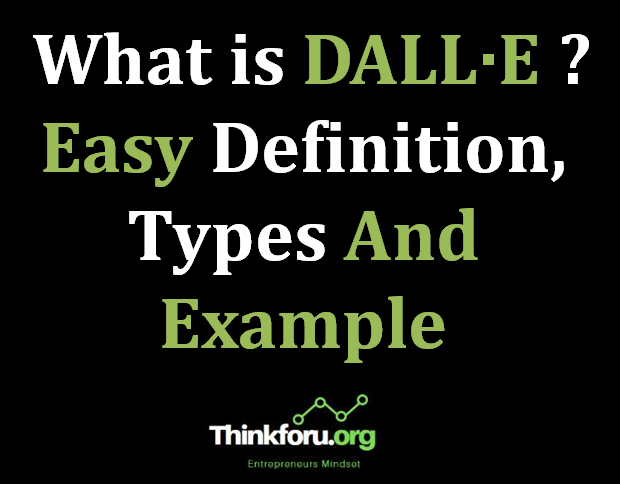What is DALL·E? Easy Definition, Types, And Example
"DALL·E" refers to an artificial intelligence model developed by OpenAI. It is a variant of the GPT-3 model designed for image generation. The name "DALL·E" is a play on the name of the artist Salvador Dalí and the Pixar character WALL·E.
Easy Definition of DALL·E :
DALL·E is a generative model that can create diverse and realistic images from textual descriptions. It belongs to the family of models known as generative adversarial networks (GANs), which are capable of generating new data samples that resemble a given training dataset.
Types of DALL·E :
DALL·E is a specific model developed by OpenAI,there aren't different types of DALL·E. However, there may be updates or new versions after that time.
Example of DALL·E :
For example, you could provide DALL·E with a textual prompt like "a two-story pink house shaped like a shoe," and it would generate an image matching that description. The model is trained on a wide range of images and can generate creative and sometimes surreal visual outputs based on textual input.
Here are a few more details about DALL·E:
1. Capabilities:
DALL·E has demonstrated the ability to generate a wide variety of images, including but not limited to animals, objects, scenes, and abstract concepts. It can understand and interpret textual descriptions to create corresponding images, showcasing its versatility in creative image synthesis.
2. Training Data:
DALL·E is trained on a large dataset containing images and corresponding textual descriptions. The model learns to map textual input to visual output, enabling it to generate novel images based on the input it receives.
3. Creative Output:
One notable aspect of DALL·E is its capacity for creative and imaginative outputs. It can generate images that go beyond straightforward interpretations of textual prompts, often producing visually interesting and novel results.
4. Limitations:
While DALL·E is impressive in its capabilities, it also has limitations. The model may sometimes generate images that are unrealistic or do not conform to the laws of physics. Additionally, it might not always capture nuanced details or subtle distinctions present in the textual input.
5. Applications:
DALL·E and similar models have potential applications in various fields, including art, design, and content creation. They can be used to generate visuals for creative projects, design concepts, or even aid in prototyping.
Here are some additional details about DALL·E:
6. Image Resolution:
DALL·E is capable of generating images at relatively high resolutions. It can create detailed pictures with dimensions that are comparable to standard photographs. This allows for the generation of visually rich and intricate images.
7. Conditional Generation:
DALL·E supports conditional generation, meaning it can take specific criteria or attributes into account when generating images. For example, you could specify the color, size, or style of an object in your textual prompt, and DALL·E will attempt to generate an image that aligns with those specifications.
8. Prompting Techniques:
Users interact with DALL·E by providing textual prompts. The choice of words and how the prompt is phrased can influence the generated output. Users often experiment with different phrasings to see how the model interprets and responds to their requests.
9. OpenAI's Research Blog:
OpenAI has released information about DALL·E and its capabilities through research blog posts, providing insights into the model's architecture, training process, and examples of its creative outputs. OpenAI's research publications are valuable resources for understanding the technical aspects of DALL·E.
10. Continued Research:
DALL·E is part of the ongoing research into generative models, and it represents a step forward in the field. OpenAI continues to explore and advance the capabilities of AI models for creative tasks, with potential implications for various applications in the future.
11. Ethical Considerations:
As with many AI models, there are ethical considerations surrounding the use of DALL·E. Issues related to bias in training data, potential misuse, and the responsible deployment of such technologies are subjects of ongoing discussions in the AI community.
That the information provided is based and there may have been further developments or updates since then. Always refer to the latest sources for the most current information.
It's important to note,developments in AI and machine learning may have occurred since then. Always refer to the latest sources for the most current information on DALL·E and related technologies.
Keep in mind that DALL·E is part of the broader field of generative models, and there may be variations or improvements to this technology in the future. Always refer to the latest sources for the most up-to-date information.


Post a Comment